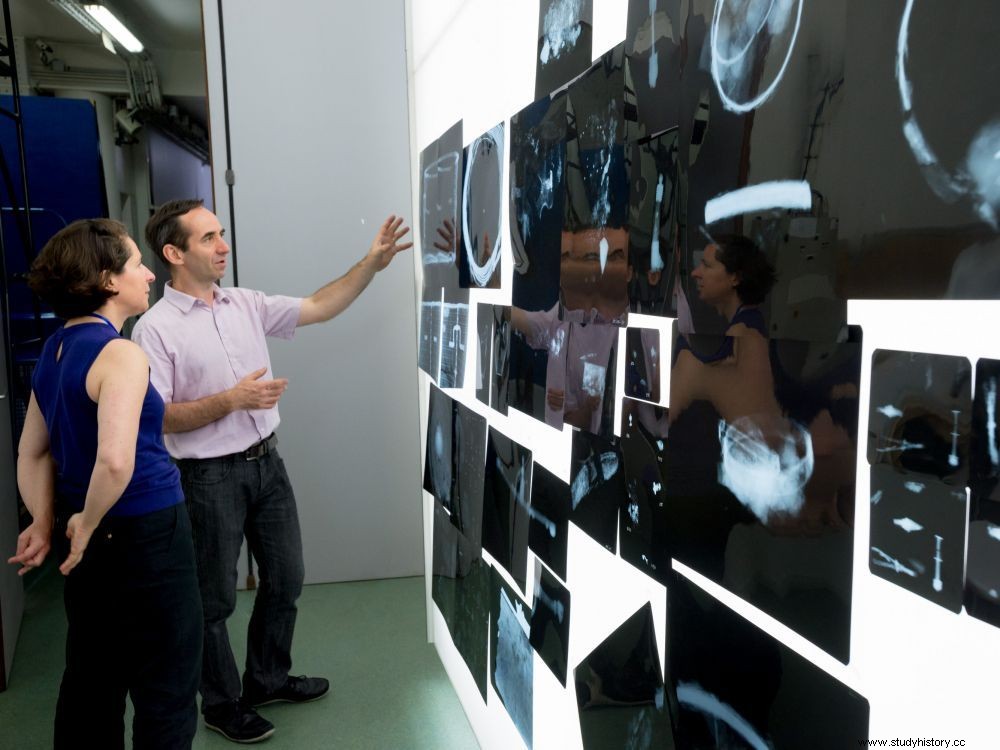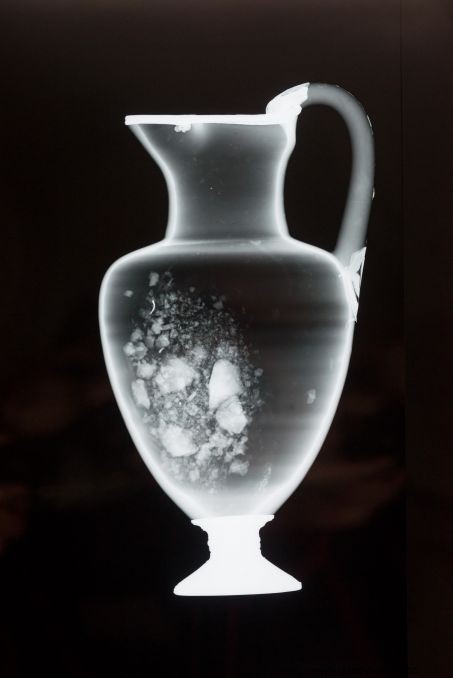The funerary furniture from one of the most important Celtic tombs discovered to date in France is being analyzed in the C2RMF laboratories in Paris.

Examination of X-rays of part of the funerary material from the tomb of Lavau (V e century BC).
A prodigious 200-litre bronze cauldron, a gold torque and bracelets, precious belt elements, banquet dishes, a knife and its sheath, the remains of a two-wheeled chariot... The extraordinary funerary furniture of Lavau (Aube), a Celtic tomb from the middle of the 5th th century before our era exhumed in March 2015, is currently being studied in the basement of the Louvre, in Paris, at the C2RMF* research and analysis laboratory dedicated to the 1220 museums of France. This treasure comes from excavations carried out by the National Institute for Preventive Archaeological Research (Inrap). These refined ornaments belonged to a young aristocrat whose body had rested for more than 2500 years in the heart of a tumulus 40 m in diameter. Undoubtedly a representative of this princely elite that appeared in Europe at the end of the Bronze Age, after the introduction of iron metallurgy (VIII e century BC. J.C).

Under consolidation, a fragment of the bronze cauldron adorned with a head of the Greek god Acheelos. This imposing container consisted of a set of 10 welded parts. © Bernadette Arnaud
Researchers are now trying to unlock its manufacturing secrets:metal shaping techniques, alloy content... So much data that could be revealed by X-ray tomography or scanning electron microscopes; similarly, traces of wear on gold objects will be explored by high-resolution 3D scanners. Because such an archaeological treasure is unique in France. The most famous discovery being that of the "Lady of Vix" (Côte-d'or) which dates back to 1953! “So much analysis is needed because of the many unanswered questions about silversmithing and Celtic art “recalls Dominique Garcia, the president of Inrap. From what raw material did the Celts work? Who performed these lavish plays? With what tools? How were these priceless items brought into circulation? Did they come from Etruria, Greece or Iberia? Was it the local productions of an indigenous society or can we see outside influences? What was their function? Why are they mostly found in burials?

Oenochoé, gold bracelets and torcs from the princely tomb of Lavau analyzed by the C2RMF laboratories. © Inrap
This research should also allow the identification of remains in organic matter (leather) as well as textiles caught in concretions. But archaeologists are mainly trying to understand if there were production "workshops" in Europe using similar techniques. The Celtic societies of Hallstatt (VIII th -V e century BCE) – the name given to the Early Iron Age Celts to distinguish them from their later La Tène successors (450-25 BCE) – did not have a monetary economy. Precious objects therefore circulated in a donation system. Gold like wine (imported from the Mediterranean) was among these peoples of the Iron Age, an ostentatious manifestation of wealth.

Study of the oenochoe, wine vase, decorated with gold thread unearthed in the Lavau burial. Tartars and wine deposits are still visible there. © Inrap
Hence these amazing drinking services made by the Greeks for the Celtic "Barbarians" found in the graves, and in particular that of Lavau. The archaeologists had unearthed there, in addition to the bronze cauldron, an oenochoé, a Greek vase enhanced with gold threads, decorated with a painted decoration embodying Dyonisos, and a silver goblet. This research should continue until 2019. A documentary on the discovery of the Celtic tomb of Lavau will be presented on Arte on June 17, 2017 as part of the National Days of Archeology (JNA) organized throughout France by the Inrap from June 16 to 18, 2017.
*C2RMF:Center for Research and Restoration of French Museums
